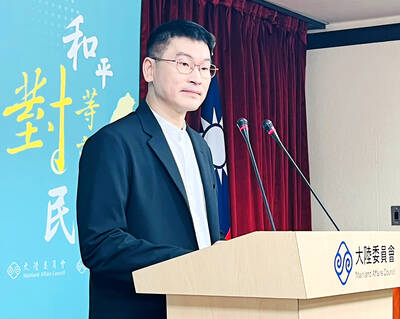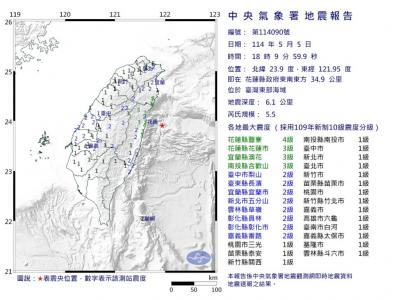Kuokuang Petrochemical Technology Co last week rejected a proposal to create an eco-corridor specifically for the passage of Indo-Pacific Humpback Dolphins by splitting the area used by the petrochemical plant in half, saying the move would increase construction costs.
The Environmental Protection Administration (EPA) hosted a meeting with experts on Thursday to evaluate the impact Kuokuang’s proposed petrochemical plant along a coastal area in Changhua County would have on one of the world’s critically endangered species.
Based on the company’s plan, the petrochemical plant would be built on reclaimed land of more than 4,000 hectares. A harbor would also be built on the reclaimed land to ship petrochemical products.
Members on the EPA’s Environmental Impact Assessment Committee recommended that Kuokuang open a passage between the petrochemical plant and the harbor and create an “eco-corridor” for humpback dolphins about 5m to 10m deep and 800m wide.
Kuokuang chairman Chen Bao-lang (陳寶郎), however, said the proposal was not feasible.
“Doing so would increase our construction costs by NT$24.5 billion [US$765 million],” Chen said. “So far, the investment has increased from approximately NT$400 billion to NT$600 billion. Our shareholders may not agree to add more money just for the sake of the dolphins.”
Environmentalists, however, said the massive development would impede the passage of the Indo-Pacific Humpback Dolphins and put their survival at risk.
The meeting opened with a briefing from a research team led by National Taiwan University professor Chou Lien-siang (周蓮香), who was commissioned by Kuokuang to assess the influence of the petrochemical plant on the humpback dolphins and make recommendations. The team concluded that the main corridor for the humpback dolphins ranges from Longfeng Fishing Harbor (龍鳳漁港) in Miaoli County and Chiangchun Fishing Harbor (將軍漁港) in Tainan County.
Using sightings and photographs, the team estimated that the number of dolphins living along the west coast of Taiwan was about 86.
“The population [of humpback dolphins] has reached a tipping point,” Chou said. “It will decrease drastically if any critical event happens from now on.”
The team also said the coastal area to the south of Changhua County was an important passage for humpback dolphins, adding that about 30 percent of the population has used the passage to move from south to north and vice versa.
“The construction of a harbor may not completely block the traffic of the dolphins,” the team said in its report. “However, with the potential interruptions from sea vessels, the animals may need more energy [to pass through the area].”
“Should the construction lead to a permanent division of the passage, the population could reach functional extinction within 13 to 75 years,” the team said. “If the division is temporary, it could potentially reduce the population by between 6 percent and 50 percent after 15 years.”

An essay competition jointly organized by a local writing society and a publisher affiliated with the Chinese Communist Party (CCP) might have contravened the Act Governing Relations Between the People of the Taiwan Area and the Mainland Area (臺灣地區與大陸地區人民關係條例), the Mainland Affairs Council (MAC) said on Thursday. “In this case, the partner organization is clearly an agency under the CCP’s Fujian Provincial Committee,” MAC Deputy Minister and spokesperson Liang Wen-chieh (梁文傑) said at a news briefing in Taipei. “It also involves bringing Taiwanese students to China with all-expenses-paid arrangements to attend award ceremonies and camps,” Liang said. Those two “characteristics” are typically sufficient

A magnitude 5.9 earthquake that struck about 33km off the coast of Hualien City was the "main shock" in a series of quakes in the area, with aftershocks expected over the next three days, the Central Weather Administration (CWA) said yesterday. Prior to the magnitude 5.9 quake shaking most of Taiwan at 6:53pm yesterday, six other earthquakes stronger than a magnitude of 4, starting with a magnitude 5.5 quake at 6:09pm, occurred in the area. CWA Seismological Center Director Wu Chien-fu (吳健富) confirmed that the quakes were all part of the same series and that the magnitude 5.5 temblor was

The brilliant blue waters, thick foliage and bucolic atmosphere on this seemingly idyllic archipelago deep in the Pacific Ocean belie the key role it now plays in a titanic geopolitical struggle. Palau is again on the front line as China, and the US and its allies prepare their forces in an intensifying contest for control over the Asia-Pacific region. The democratic nation of just 17,000 people hosts US-controlled airstrips and soon-to-be-completed radar installations that the US military describes as “critical” to monitoring vast swathes of water and airspace. It is also a key piece of the second island chain, a string of

The Central Weather Administration has issued a heat alert for southeastern Taiwan, warning of temperatures as high as 36°C today, while alerting some coastal areas of strong winds later in the day. Kaohsiung’s Neimen District (內門) and Pingtung County’s Neipu Township (內埔) are under an orange heat alert, which warns of temperatures as high as 36°C for three consecutive days, the CWA said, citing southwest winds. The heat would also extend to Tainan’s Nansi (楠西) and Yujing (玉井) districts, as well as Pingtung’s Gaoshu (高樹), Yanpu (鹽埔) and Majia (瑪家) townships, it said, forecasting highs of up to 36°C in those areas